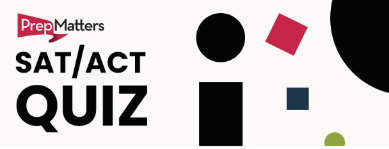Posted by: Ned Johnson on February 10, 2025
The Digital SAT has finally arrived! While I am kind of an analog guy, the SAT, like many things in our world, has adapted to our screen-based society. And while some lessons can be learned from the practice tests made available from College Board, there are different lessons to be learned from taking the actual test itself. So, what did we learn?
But, before we launch it to what we learned from taking the test, allow me to answer the question that may hang in the air: Wait, tutors take the SAT? Yep, my colleagues and I take the SAT and ACT for two primary reasons:
- We want to see for ourselves what the SAT is like and what the SAT experience is like. It’s also important to note that with the new digital SAT, College Board no longer releases a copy of the test that students take. Therefore, we cannot go over the questions with them, and it is difficult for students to both do the test and assess how they are doing. Doing two things at once imposes a really high cognitive load, so it helps us as tutors to take the test itself. Shooting hoops in a gym without the crowd does little to inform what the experience is like shooting a game winner as the clock winds down. While we read closely everything that College Board shares about the SAT and listen closely to what our students report, experience has taught us that we may not be getting the full picture. As President Reagan intoned, “Trust, but verify.”
- We take the SAT and ACT to appreciate the subjective experience of what it’s like to take a high-stakes, early morning test that creates anxiety for pretty much everyone, from proctors to students to middle-aged test prep geeks like me. Boots-on-the ground observation allows us to better advise students and, honestly, garners us a tad bit of street cred. You know, if you lived on a nerdy street in an academic neighborhood with rival gangs of Scholars and Geeks. And, yes, to answer your question: We are allowed to take the SAT. For better or for worse, there is no age limit to the SAT. To my amusement, taking the SAT is often the penalty paid by 20-somethings who lose their fantasy football leagues, which could also be your fate as a parent if you push your kid too much – be careful how much you hassle or harangue your student to put in more effort, lest you elicit an invitation to join them one Saturday morning!
So how does the new SAT feel to take? Many of the changes students profess to love about the new test don’t necessarily make the test easier or better for them. How so? Well, let’s start with what makes the SAT difficult. Well, not just the SAT, but today’s SAT. While parents may have memories of vocab cards and #2 pencils, the SAT that students experience students today is quite different, as is the experience of taking it. While students did veritable cartwheels at the announcement of changes on the new SAT that seemed to promise an easier SAT – shorter passages, no more “SAT words” vocabulary, Desmos (an embedded sophisticated graphing calculator), and nearly an hour less of testing time, on a computer no less! Shorter and easier? What’s not to love?!? Folks like me who have watched multiple iterations of “New SATs” (five and counting for me) reserved our judgment with more than a modicum of skepticism. Shorter can be measured several ways. Shorter may not mean easier. Easier is not about individual questions but the test as a whole. As with every change, something has to give.
Why the Digital SAT is Easier for Students
First, some good news. Technologically, College Board has its act together. Fears of crashing servers and seizing systems that haunted the dreams of students and critics never materialized. Thank heavens! While the first digital PSAT in October 2023 had widely reported hiccups, today’s SAT is pretty darned smooth. Good news for all. That being said, students should read (and parents should confirm) BlueBook Instructions. The few tech errors we see are usually PEBCAK errors – which is to say, avoidable.
And, as expected, a shorter SAT does, in fact, take less time. Surprise! The good news is that students are no longer taking a test that bridges lunch, especially a concern for students with extra time accommodations. At the SAT I took, there was some kind of proctoring issue that caused us to be 30 minutes behind other classrooms, but we were still out before noon. Sadly, College Board has not used the opportunity of a shorter testing time to create a later testing time – ignoring a small mountain of evidence and a recommendation by the American Academy of Pediatrics for later start times for teens.
Why the Digital SAT is Harder for Students
But, does shorter mean easier? Well, not so fast. Classically, the difficulty of standardized tests is predicated on two factors:
- Power – the absolutely difficulty of questions and,
- Speediness – how much stuff in how little time.
One of the things that caught our attention in early pronouncements (aka marketing efforts) by College Board was touting a shorter test format, increased time per question, and shorter bodies of text. Well, golly, shouldn’t that make it easier? Seems so, right? Except, the SAT is a standardized test. Normal distributions (aka bell curves) are the coin of the realm for test makers (fancy statisticians called psychometricians), so something has to make the test and certain questions difficult, at least for some test takers. To keep score parity from the old SAT to the new SAT, lower speediness means greater power. On math, that tends to mean either more advanced or “trickier” problems. On reading, increased power is found in harder vocabulary and syntactic complexity (read: complex, wordy sentences). Is that what happened? (Spoiler alert: That is what happened.)
The new SAT Reading section: Is shorter better?
Arguably the thing I hear most from students who voice a preference for the SAT over the ACT is that they just “hate” the long reading passages. So, shorter has to be better, right? There are many reasons that many students dislike and struggle with reading long(ish) texts, and it’s not just TikTok. Kids (and adults) don’t read the same as in years past. To begin with, most of my students report that they have never had physical textbooks. There are many reasons why, most of which are likely financial. Instead, they get texts provided in pieces, usually digital. And, there are really significant differences between how brains process texts on screens versus in print. Because of our changing habits, people today simply have shorter attention spans. In her 2023 ground-breaking book Attention, researcher Gloria Mark shines light on our dwindling attention. “Back in 2004, we found the average attention span on any screen to be two and a half minutes on average. Throughout the years it became shorter. So around 2012 we found it to be 75 seconds….This is an average. And then in the last five, six years, we found it to average about 47 seconds…The median is 40 seconds. And what this means is that half of all the measurements that we found were 40 seconds or less of people’s attention spans.”
Previous versions of the SAT had reading passages that were typically 60-90 lines of text, which most students read in three to four minutes – if they read the text at all!! At a conference I attended in the run-up to the digital SAT, College Board shared that one reason for the changes from long passages to short ones was that they found far too many students were simply not reading the passages. Much like people skim webpages for what they are looking for, students were doing the same. And, it turns out that students were not doing well on reading comprehension questions when they did not in fact read passages to comprehend them. Who knew?!? In response, College Board made the passages (if you can call then that) shorter, typically 8-9 lines of text.
Ok, sure, but still shorter is easier, right? Well, maybe. To begin with, while the length of passages has shrunk, the average number of words per question remains robust. In promoting the new SAT, College Board strained to emphasize the greater time per question. Fair. On the ACT, a typical reading passage is 80-90 lines long. For many students, that feels like a lot. With ten questions per passage, that’s 8-9 lines per reading question, roughly 80 words per question. On English (mostly punctuation and transitions), about 20 words per question. And, the SAT? The reading and English are combined with roughly 105 words per question. And, while the SAT does give more time per question than the ACT (1.23 min vs. 0.7 minutes per question), the words per minute is flipped: 85 words per minute on the SAT while the ACT is 88 words per minute on reading 35 words per minute on English, a blended rate 41 words per minute.
Of course, all questions and all words are not equally difficult. While the SAT famously jettisoned “SAT words” and no longer discretely tests difficult vocabulary with analogies and antonyms, it does discreetly test vocabulary, with words that many students don’t know obscuring the meaning of the sentences themselves. The length of sentences is only one measure of their difficulty. In fact, many types of lexile scores exist to rate the reading level of texts for this very reason: Vocabulary and sentence complexity both matter!
For example:
Some questions can be hard to understand because of the complex structure and unfamiliar vocabulary in the sentences.
is easier to understand than
Because of variations in syntactical complexity and esoteric diction, diverse questions may not be uniformly comprehensible.
Simply put, the hardest reading questions on the SAT have both increasingly difficult vocabulary and more complex sentence structure. The lexile score of the SAT is nearly two grade levels higher. The hardest reading questions on the SAT are harder than the hardest reading questions on the ACT.
So, what can you do to be prepared for the challenges brought by the new SAT? Stay tuned for the next blog post about working memory!




